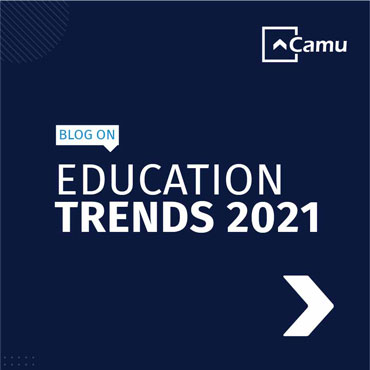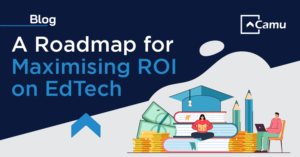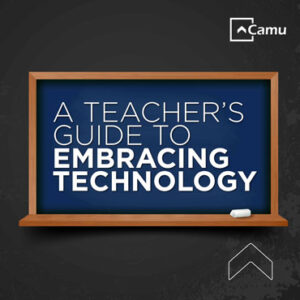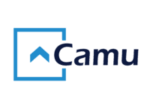
Engaging with Education Trends 2021
The world of education is dynamic.
Constantly evolving, adapting, innovating, growing.
Bringing to students, the best possible learning tools and tactics imaginable.
Cloud-based Technologies. Mobile-first Platforms. Blended Learning Modules. Integrated LMS and SIS. Proctored Examinations. Student Digital Services.
The list goes on!
Camu, a leading campus management solution provider, has put together a list of the latest trends in the EdTech industry.
Carrying forward from 2020, here are some of 2021’s biggest changemakers.
1. Video Based Learning
As its name suggests, Video-Based Learning is a form of eLearning that allows students to acquire skills and gain knowledge via the video format. With the estimated number of global internet users steadily rising, this form of instruction is likely to become a convenient solution for all higher education learners. Video-Based Learning is scalable and can be used repetitively. Thus, a student can watch the same video many times until he/she has grasped the concept.
2. Blockchain
Blockchain can be described as a data structure that holds transactional records, whilst ensuring security, transparency, and decentralization. For higher education, this means transforming the “record-keeping” of degrees, certificates, and diplomas. Additionally, making credentials digital and placing them under the learner’s control, without the need for an intermediary to verify their authenticity. Blockchain could be also used for the accreditation of educational institutions.
3. Online Assessment Techniques
A critical success factor for student evaluation is an efficient assessment model. Higher education institutes are increasingly looking towards platforms that can help simplify and automate the examination process. Did you know, artificial intelligence-driven algorithms can evaluate theory-based answers? The software compares answers with benchmark answers for better accuracy prediction. It’s no surprise – machine-driven evaluation is likely to become the norm in the coming years!
4. Self-Paced Learning
Every student’s academic journey looks a little different. And educational institutes are realizing the importance of providing them the freedom and flexibility to study at their own, unique pace. The last 18 months have witnessed a significant increase in certification programs that are exclusively taught online. Students can view recorded lectures, participate in live chats with instructors, and learn from any location. They can even appear for examinations from their preferred locations across the globe.
5. Artificial Intelligence
Artificial Intelligence – intelligence demonstrated by machines – has conquered multiple sectors and is soon to dominate EdTech as well! Its influence can already be seen in several domains such as facial recognition for attendance, invigilation for online examinations, evaluation for personalized feedback, and more. Thanks to AI, digital learning interfaces can adapt to diverse students’ needs in real-time, providing the lessons and exercises that are required to fill in knowledge gaps and reinforce concepts.
6. Virtual Reality
Virtual Reality can enhance higher education by providing students with memorable and immersive experiences, that would otherwise not be possible. Through life-like simulations, students are transported out of the classroom and into various educational scenarios. They are given the rare opportunity to learn through experience and their imagination is allowed to bloom. The idea is to explore practices beyond the traditional methods of reading and writing.
7. Internet of Things (IoT)
As instructional approaches and learning opportunities continue to foray ahead, IoT helps build a better-connected and more collaborative future for education. IoT devices empower students with more access to everything, from learning resources to support functions and communication channels! Additionally, it grants teachers the ability to measure student learning/progress in real-time.
8. Chatbots
Artificial Intelligence Chatbots are much like Virtual Teaching Assistants; their job is to reduce the cycle of tasks assigned to the teacher on a day-to-day basis. Taking some of the burdens away from faculty, these bots are capable of answering queries, curating lesson plans, creating course modules, building assignments, and setting deadlines. They can even monitor students’ learning progress and provide personalized feedback, individually! A chatbot can play an instrumental role in guiding students, from enrolment to graduation.
9. Podcasting
A podcast is an audio recording that can be downloaded and listened to, via a smart device such as a mobile phone, laptop, or tablet. Deemed as the ‘millennial’s radio’, this flexible new-age format is thriving with content creators – pan-industry – innovating different ways to engage their audiences. The education sector has been quick to follow suit, as they’ve understood the merit and value of disseminating knowledge on the go.
10. Gamification
The idea behind applying gamification to higher education is quite simple. Learners learn best when they are having fun! This creative practice is gaining swift momentum in the educational world and involves the use of game-based elements like point systems, peer competition, teamwork, score tables, and more, to help students assimilate new information and apply their knowledge effectively. For more updates on the EdTech industry, stay tuned to our next blog titled ‘Education insights for 2021’.







